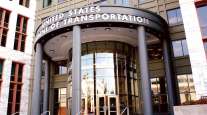Senior Reporter
Federal Regulators Tout Autonomous Vehicles’ Potential Benefits

Commercial vehicles utilizing automated technology have the potential to increase highway safety and provide a boost to the economy, the country’s top trucking regulator said June 19.
“This may very well be one of the tools that will lead us to safer roadways,” Federal Motor Carrier Safety Administration chief Ray Martinez said during a forum on autonomous vehicles at the University of Michigan’s Mcity, a research and testing site.
“Automation can reduce congestion, which can improve productivity and limit the cause associated with crashes,” Martinez added. “When freight moves with more efficiency, it reduces the price of goods and stimulates economic growth.”
The agency is seeking input from stakeholders as it readies an advance notice of proposed rulemaking for commercial vehicles equipped with automated driving systems. Publication of the notice is scheduled for December.
Specifically, FMCSA is aiming to learn from stakeholders whether drivers would be needed inside autonomous trucks operating on the roadways, the challenges of developing the technology around the country and the requisite technology to safely deploy autonomous trucks.

In our debut episode of RoadSigns, we ask: What does the move toward autonomy mean for the truck driver? Hear a snippet from Alex Rodrigues, CEO of Embark, above, and get the full program by going to RoadSigns.TTNews.com.
The agency also is seeking input from the industry on specific training requirements for maintenance and inspection personnel, and whether regulators should develop minimum qualifications for personnel tasked with overseeing the technology’s maintenance.
While federal officials craft policy, state and municipal agencies have begun testing and facilitating the use of autonomous vehicles. Technology firms continue to examine the progress of autonomous vehicles in major cities.
Ride-hailing and tech companies are aiming for the technology’s mainstream deployment. Proponents tout the potential for improving safety by addressing impaired driving, distraction and speeding. Other observers note the cost associated with infrastructure upgrades necessary to connect large numbers of autonomous and connected cars and trucks on the road. Quality wireless communication would be a key priority for the technology to function.
Last year, American Trucking Associations announced its policy views on the emergence of automated driving technologies in trucking. The federation’s position emphasized a need to promote safety along freight corridors, promote the flow of interstate commerce, ensure the federal government is solely responsible for regulating the technology and guarantee investments in infrastructure and connectivity.
On Capitol Hill, the Senate has yet to consider legislation approved by the Commerce Committee meant to facilitate the development of self-driving vehicles. The bill’s sponsors have not said when the legislation would reach the chamber’s floor despite strong support from most of the industry. The House advanced similar legislation last year. Policy specific to the trucking industry is absent in both bills.
Asked what role the federal government would need to play on the matter, Sen. Tom Carper of Delaware, ranking Democrat on the Senate transportation panel, told Transport Topics: “In some of our, certainly our major thoroughfares — major roads, highway systems where there’s a clear federal role and a state role — I think there’ll be an expectation for the federal government to have an involvement and to play a role, a supportive role.”




